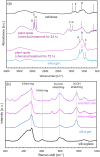Biogenic design of silicious architectures on Moso bamboo culm
- PMID: 40596399
- PMCID: PMC12219570
- DOI: 10.1038/s41598-025-06906-w
Biogenic design of silicious architectures on Moso bamboo culm
Abstract
Biosilicas that are produced in vascular plants (plant opal), such as Poaceae, have a variety of shapes and functions and are regarded as an excellent model for the architectural design of artificial amorphous materials. In this work, we studied the micro- and nanostructures and mechanical and optical functions of plant opals on the bamboo culm, which is available as an important natural material. The surface of the culm wall is totally covered with silicified epidermal cells containing silica wedges. The biogenic silicious architectures, such as silicified cell walls and wedges, are composed of nanoscale particles ~ 20-80 nm in diameter with cellulose nanofibrils. Silica wedges, which have a relatively low organic content and relatively high hardness and Young's modulus, are initially formed on cellulose nanofibrils in an organic frame as a scaffold within a few weeks after the emergence of a bamboo shoot. Several months after the formation of the wedges, the epidermal cell walls, which protect the culm surface, are lightly silicified with cellulose nanofibrils. According to a numerical simulation, the silica wedges would have an optical function delivering sunlight to chloroplasts located under the epidermal cells.
© 2025. The Author(s).
Conflict of interest statement
Competing interests: The authors declare no competing interests.
Figures








Similar articles
-
Structural adaptations of curved-stem moso bamboo: tissue specialization for resilience under mechanical stress.Acta Biomater. 2025 Aug;202:365-376. doi: 10.1016/j.actbio.2025.07.020. Epub 2025 Jul 9. Acta Biomater. 2025. PMID: 40645317
-
Exploring silica accumulation in bamboo leaves: a study on phytolith morphology and epidermal patterning in the tropical giant bamboo Dendrocalamus copelandii.Ann Bot. 2025 Mar 13;135(4):757-768. doi: 10.1093/aob/mcae209. Ann Bot. 2025. PMID: 39673403
-
A rapid and systematic review of the clinical effectiveness and cost-effectiveness of paclitaxel, docetaxel, gemcitabine and vinorelbine in non-small-cell lung cancer.Health Technol Assess. 2001;5(32):1-195. doi: 10.3310/hta5320. Health Technol Assess. 2001. PMID: 12065068
-
Comparison of cellulose, modified cellulose and synthetic membranes in the haemodialysis of patients with end-stage renal disease.Cochrane Database Syst Rev. 2001;(3):CD003234. doi: 10.1002/14651858.CD003234. Cochrane Database Syst Rev. 2001. Update in: Cochrane Database Syst Rev. 2005 Jul 20;(3):CD003234. doi: 10.1002/14651858.CD003234.pub2. PMID: 11687058 Updated.
-
A Systematic Review on the Hazard Assessment of Amorphous Silica Based on the Literature From 2013 to 2018.Front Public Health. 2022 Jun 15;10:902893. doi: 10.3389/fpubh.2022.902893. eCollection 2022. Front Public Health. 2022. PMID: 35784253 Free PMC article.
References
-
- Wang, T., Antonietti, M. & Cölfen, H. Calcite mesocrystals: ‘morphing’ crystals by a polyelectrolyte. Chem. Eur. J.12, 5722–5730 (2006). - PubMed
-
- Miyajima, R., Oaki, Y., Kogure, T. & Imai, H. Variation in mesoscopic textures of biogenic and biomimetic calcite crystals. Cryst. Growth Des.15, 3755–3761 (2015).
-
- Ehrlich, H. Chitin and collagen as universal and alternative templates in biomineralization. Int. Geol. Rev.52, 661–699 (2010).
MeSH terms
Substances
Grants and funding
LinkOut - more resources
Full Text Sources

